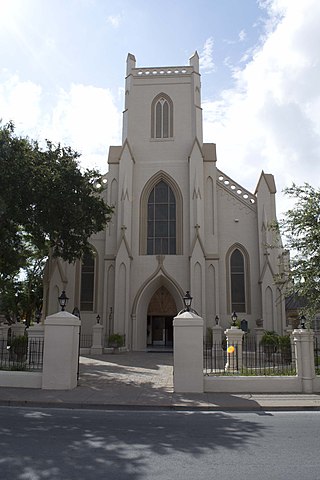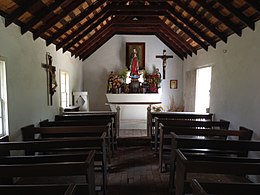
Mission is a city in Hidalgo County, Texas, United States. Its population was 77,058 at the 2010 census and an estimated 84,331 in 2019. Mission is part of the McAllen–Edinburg–Mission and Reynosa–McAllen metropolitan areas.

Roma is a city in Starr County, Texas, United States. Its population was 11,561 at the 2020 census. The city is located along the Rio Grande, across from Ciudad Miguel Alemán in Tamaulipas, Mexico. The city is also popularly known as Roma-Los Saenz, since the incorporated city also took the area known as Los Saenz. It serves as a port of entry from Mexico into the U.S. via the Roma–Ciudad Miguel Alemán International Bridge.

The Lower Rio Grande Valley, commonly known as the Rio Grande Valley or locally as the Valley or RGV, is a region spanning the border of Texas and Mexico located in a floodplain of the Rio Grande near its mouth. The region includes the southernmost tip of South Texas and a portion of northern Tamaulipas, Mexico. It consists of the Brownsville, Harlingen, Weslaco, Pharr, McAllen, Edinburg, Mission, San Juan, and Rio Grande City metropolitan areas in the United States and the Matamoros, Río Bravo, and Reynosa metropolitan areas in Mexico. The area is generally bilingual in English and Spanish, with a fair amount of Spanglish due to the region's diverse history and transborder agglomerations It is home to some of the poorest cities in the nation, as well as many unincorporated, persistent poverty communities called colonias. A large seasonal influx occurs of "winter Texans" — people who come down from the north for the winter and then return north before summer arrives.

The Mexico–United States barrier is a series of vertical barriers along the Mexico–United States border intended to reduce illegal immigration to the United States from Mexico. The barrier is not a continuous structure but a series of obstructions variously classified as "fences" or "walls".

The Spanish Missions in Texas comprise a series of religious outposts established by Spanish Catholic Dominicans, Jesuits, and Franciscans to spread the Catholic doctrine among area Native Americans, but with the added benefit of giving Spain a toehold in the frontier land. The missions introduced European livestock, fruits, vegetables, and industry into the Texas area. In addition to the presidio and pueblo (town), the misión was one of the three major agencies employed by the Spanish crown to extend its borders and consolidate its colonial territories. In all, twenty-six missions were maintained for different lengths of time within the future boundaries of the state of Texas.

The Mexico–United States border is an international border separating Mexico and the United States, extending from the Pacific Ocean in the west to the Gulf of Mexico in the east. The border traverses a variety of terrains, ranging from urban areas to deserts. The Mexico–U.S. border is the most frequently crossed border in the world with approximately 350 million documented crossings annually. It is the tenth-longest border between two countries in the world.

The Roman Catholic Diocese of Brownsville is a Latin Church in the southern part of Texas in the United States.
John Conway founded the city of Mission, Texas in 1907 with J. W. Holt when the two purchased the 17,000-acre (6,900 ha) La Lomita Ranch from the Oblate fathers. Subdivided parcels were sold to arriving settlers and water was pumped from the Rio Grande by means of a pumping station called the First Lift Station and distributed to the residents of the Rio Grande Valley through the Mission Canal Co. Irrigation System, also started by Conway and Holt.

Havana Cathedral is one of eleven Catholic cathedrals on the island. It is located in the Plaza de la Catedral on Calle Empedrado, between San Ignacio y Mercaderes, Old Havana. The thirty by forty-nine meters rectangular church serves as the seat of the Roman Catholic Archdiocese of San Cristóbal de la Habana. Christopher Columbus’ remains were kept in the cathedral between 1796 and 1898 before they were taken to Seville Cathedral.

The Episcopal Diocese of the Rio Grande is the Episcopal Church's diocese in New Mexico and southwest Texas, the portion of the state west of the Pecos River, including the counties of El Paso, Reeves, Culberson, Jeff Davis, Brewster, Presidio, Terrell, Hudspeth and Pecos. The total area of the diocese is 153,394 square miles (397,290 km2). According to the 2006 parochial report, there are 57 active congregations within the diocese. The see is based in Albuquerque, New Mexico and the diocesan cathedral is the Cathedral Church of St. John.

The Cathedral of San Agustin is the seat of the Catholic Diocese of Laredo, Texas. It is located at 201 San Agustin Avenue in the heart of the downtown area in the San Agustin Historical District. The present church building dates from 1872. The bishop is James Anthony Tamayo. As of 2000, the cathedral was the mother church for 289,415 Catholics in the diocese.

Immaculate Conception Cathedral is a historic church at 1218 East Jefferson Street in Brownsville, Texas, United States. It is the cathedral church for the Roman Catholic Diocese of Brownsville. It was built in 1856 and added to the National Register of Historic Places in 1980 as Immaculate Conception Church.

The Ysleta Mission, located in the Ysleta del Sur Pueblo within the municipality of El Paso, Texas, is recognized as the oldest continuously operated parish in the State of Texas. The Ysleta community is also recognized as the oldest in Texas and claims to have the oldest continuously cultivated plot of land in the United States.

The Presidio Chapel of San Elizario was built in 1877 at the same place where an earlier Mexican chapel stood. The building is located in the central square of San Elizario, 17.5 miles south-southeast of El Paso. It was listed on the National Register of Historic Places in 1972. It is an example of the Spanish Colonial style.

The Trump wall, commonly referred to as "The Wall", is an expansion of the Mexico–United States barrier that started during the U.S. presidency of Donald Trump and was a critical part of Trump's campaign platform in the 2016 presidential election. Throughout his 2016 presidential campaign, Trump called for the construction of a border wall. He said that, if elected, he would "build the wall and make Mexico pay for it". Then-Mexican president Enrique Peña Nieto rejected Trump's claim that Mexico would pay for the wall; all construction in fact relied exclusively on U.S. funding.

The National Butterfly Center is a private nature preserve operated by the North American Butterfly Association that serves as an outdoor butterfly conservatory. It is located adjacent to Bentsen-Rio Grande Valley State Park, near the city of Mission in Hidalgo County in the U.S. state of Texas.

Brian Kolfage is an American political activist, former United States Air Force airman, and convicted fraudster. He co-founded We Build the Wall, a private organization that purportedly aimed to construct a privately-funded barrier on the Mexico–United States border; he pleaded guilty in 2022 to federal fraud and tax crimes for defrauding donors to the group.

The Cavalry of Christ were Oblate fathers who traveled long distances on horseback to minister to Catholics living on isolated ranches in the Rio Grande region from 1849 to 1904.

Pierre Yves Kéralum OMI (1817–1872) was a French-born Catholic missionary and member of the Missionary Oblates of Mary Immaculate. He served in South Texas from 1853 to 1872, traveling long distances on horseback to minister to Catholics living on isolated ranches along the Rio Grande. He was also an architect who designed many buildings in the area, including the Immaculate Conception Cathedral in Brownsville, Texas.

The National Emergency Concerning the Southern Border of the United States was declared on February 15, 2019, by President of the United States Donald Trump. Citing the National Emergencies Act, it ordered the diversion of billions of dollars of funds that had been appropriated to the U.S. Department of Defense for military construction. Trump declared the emergency after he signed, but derided, a bipartisan funding bill containing border security funding without funding for the border wall that Trump demanded.
























